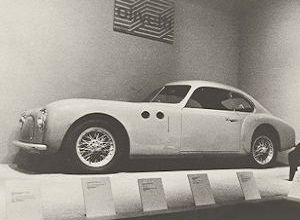Most people have never heard of Cisitalia but, without the landmark Pininfarina design for the elfin 202 coupé, today’s cars would look very different. It was the first “modern” looking GT car to establish leading Italian stylists. Its hood was lower than its front wings; its headlights blended into the body rather than being freestanding; and its unadorned, low-slung profile broke away from the bulky, traditional look that cars still retained.

Cisitalia 202 1947
- YEAR REVEALED 1947
- PLACE OF ORIGIN Turin, Italy
- HISTORICAL STATUS production car
- ENGINE four-cylinder, 66ci (1,089cc)
- MAXIMUM POWER 55bhp
- LAYOUT front-mounted engine driving the rear wheels
- BODYWORK two-door two-seater coupé
- TOP SPEED 105mph (169kph)
- NUMBER BUILT 170 (estimated)
Its hood was lower than its front wings; its headlights blended into the body rather than being freestanding; and its unadorned, low-slung profile broke away from the bulky, traditional look that cars still retained. Its wings, for instance, were totally integrated into the bodywork rather than suggesting old-fashioned fenders, but its overall shape was utterly harmonious.
Critics soon recognized its masterpiece status. The New York Museum of Modern Art has, since 1951, kept a 202 in its permanent collection. Cisitalia was founded in 1946 by racing driver, businessman, and one-time soccer player Piero Dusio. Calling on the services of Fiat engineer Dante Giacosa, the company’s first project was a single-seater racing car with Fiat front suspension and engine.
This was followed in 1948 by the 202, using essentially the same mechanical package and tubular spaceframe under that Pininfarina-designed and built body. Thanks to extremely slippery aerodynamics, the Cisitalia top sped 100mph (161kph) on just 55bhp from the tuned 66ci (1,089cc) engine. But it wasn’t to last. In 1949, Cisitalia faced bankruptcy due to over-ambitious plans for a Porsche-designed Grand Prix car. Dusio decamped to Argentina, but the 202 continued in production until 1952.